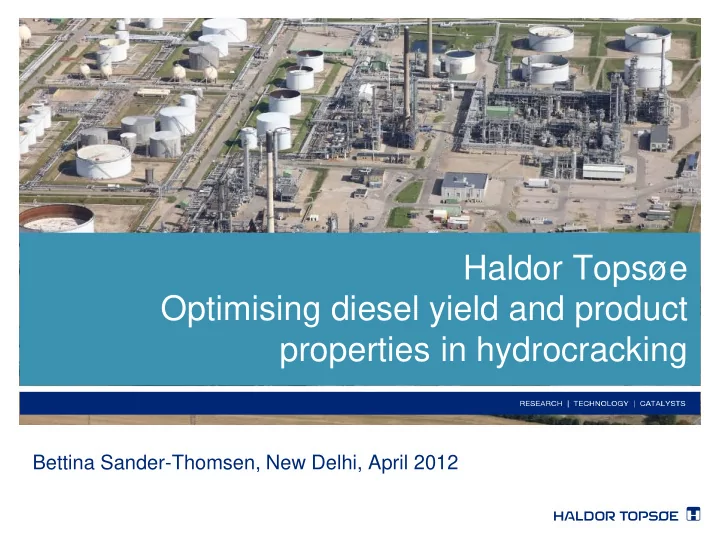

Haldor Topsøe Optimising diesel yield and product properties in hydrocracking Bettina Sander-Thomsen, New Delhi, April 2012
Outline Topsøe in hydrocracking Importance of pretreatment – Changes in feedstock properties – Changes in unit requirements Red or blue series Topsøe hydrocracking catalysts – Arctic diesel – Lube oil production – H 2 utilisation 3 different hydrocrackers – Objectives – Evaluation – Solution – Conclusion
Topsøe in hydrocracking Supplier of complete catalyst port folio for middle distillate hydrocracking since the 90’ies Hydrocracking technology supplier since the 90’ies More than 40 charges of hydrocracking catalyst installed Large R&D group focusing on development of hydrocracking catalysts and technology
Pretreatment catalysts Driving force to develop new PTR catalysts? – Continuously increasing severity of feeds – Continuously increasing requirements for barrels processed – Continuously increasing product requirements – Most hydrocrackers are limited in PTR activity Newest development TK-607 BRIM – Successor of TK-565 and TK-605 BRIM – Based on the BRIM technology – High stability and high HDN activity
Features of Red and Blue series TK catalysts Red series Blue series – Improve hydrogenation – Improve cold flow properties – Make UCO for lube oil – Improve quality of jet fuel production of ethylene – Reduce H 2 consumption crackers Middle distillate selectivity TK-926 TK-925 TK-933 TK-931 TK-943 TK-947 TK-941 Blue series TK-951 Red series Activity
3 Case stories Unit 1 2 3 Pressure, bar 150 160 140 Conversion, % 50-60 >80 60-70 Feed type VGO VGO HVGO + VBGO N, wt ppm 1500 1475 955 SG 0.92 0.93 0.914 FBP, C 590 570 590
Hydrocracker 1 Objectives – Cold flow properties of diesel – Low density of kerosene – High density of UCO to meet heat balance in FCC Red series vs. Blue series – Testing Yields Cold flow properties Kerosene properties UCO properties – Conclusion: Best result = Blue Series Commercial results
Hydrocracker 1 Test results Catalyst system Red Blue Stacked Target Middle distillate yield Base Base + 1% Maximise H 2 consumption Base Base Minimise Diesel cloud point, C -10 -15 Minimise UCO density 0.86 0.87 >0.870 Diesel CI 55 55 Maximise
Commercial performance (#1) Diesel cloud point – 3 to -15°C – Lower conversion UCO in diesel – Stopped using additives to improve cold flow properties UCO density > 0.870 10 Diesel cloud point, °C Diesel CI = 55-59 0 H 2 cons. as expected Good activity -10 Good stability -20 150 50 100 0 Run day
Hydrocracker 2 Objectives: – Low BMCI and high VI of UCO Red series vs. Blue series – Test results – Conclusion: Best result = Red series Commercial results
Hydrocracker 2 Test results Catalyst system Red Blue Stacked Target Middle distillate yield Base Base+1% Maximise H 2 consumption Base Base-3% Minimise Diesel cloud point, C -13 -31 Not important Diesel pour point, C -21 -37 Not important UCO VI 142 80 >135 UCO BMCI 7 25 <12
Commercial performance (#2) BMCI and VI fulfilled throughout entire cycle Stable and good middle distillate yields H 2 consumption in line with expectations Client recently installed a new charge of Topsøe hydrocracking catalyst for this unit 20 200 BMCI VI 175 15 BMCI VI 150 10 5 125 100 0 0 100 200 300 400 500 600 700 800 Run days
Hydrocracker 3 Objectives: – Diesel + Jet yield and properties Red series vs. Blue series – Test results – Conclusion: Best result = stacked bed Commercial results
Hydrocracker 3 Test results Catalyst system Red Blue Stacked Target Middle distillate yield Base Base+1% Base Maximise H 2 consumption Base Base-10% Base-5% Minimise Diesel cloud point, C -19 -33 -24 Minimise Diesel pour point, C -28 -50 -34 Minimise Diesel CI 64 53 57 >52 Diesel SG 0.84 0.88 0.85 <0.85
Commercial performance (#3) Low cloud point? – Diesel contains 15-20% UCO 10 Exceeding CI and density Diesel cloud point, °C requirement – CI = 55-65 0 – Density = 820-840 kg/m 3 -10 Diesel yield exceeded predicted values – Due to changes in cut points -20 60 80 0 20 40 the diesel yield exceeded the Run day test diesel yield by >15% H 2 consumption as expected Good activity
Perspectives for stacked bed loadings Use temperature control to move conversion to different beds to adjust the product quality – Example: Increase temperature in beds with Blue series catalysts in the winter to improve cold flow properties – Example: Lower severity on blue series catalyst when producing lubes
Conclusion Topsoe improved pretreatment catalysts enable refiners to process higher severity feeds It is possible to obtain the required product properties by tailoring the catalyst loading The performance of Topsoe catalysts for hydrocrackers has been demonstrated by commercial operation
Questions
Recommend
More recommend